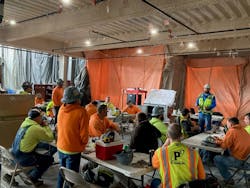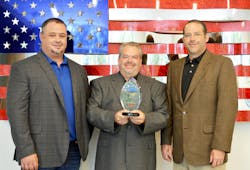Prioritizing Safety in HVACR Contracting: Strategies for Success
Safety is one of the most important factors for HVACR contractors. At the end of the day, business owners want their employees to go home to their families. Safety can also lead to significant financial savings for firms by reducing workplace accidents, minimizing downtime, and lowering insurance premiums.
“Insurance is a big cost to doing business,” notes Justin Crandol, MS, CSP, ARM, CRIS, director of safety for Sheet Metal and Air Conditioning Contractors' National Association (SMACNA). “If you don’t have any safety or health policies in place, any insurance company is going to be skittish in providing you with insurance.”
On the other end of things, if you’re safety program is not up to snuff, so to speak, your firm won’t even be considered for a project, according to Don Campbell, CHST, vice president of P1 Construction LLC. Campbell just celebrated 23 years with his firm, and while he previously served as vice president of safety, he is still the top safety official at the company.
“If you’re going to bid on a project now, many of them require you to pass through a third-party qualifier to prove your company has a good safety and health background,” Campbell says. “If your incident rates are too high, if you’ve had too many accidents, OSHA citations, if you don’t fit their bill, you can’t work on their project, regardless of how good your production quality may be. Fifteen years ago, you would go to interviews and bid jobs, and it was all about how much you were charging and when you could have it done. Today, if your safety program’s not strong enough, then you’re not even going to be thought of for a project.”
Campbell also notes that safety programs promote savings when it comes to employee retention.
“Ever since 2002, when I’ve been here, I’ve seen a big shift in people,” he says. “Instead of saying, ‘Oh, here comes the safety person,’ to ‘I like working for a company that puts my safety first.’”
Flipping the Mindset
Granite City, Illinois-based icon Mechanical won the 2024 SMACNA Safety Innovator of the Year award last fall for its creative “Good Catch” program, a safety initiative aimed at mitigating accidents by rewarding employees for catching and reporting hazards.
icon Mechanical uses Microsoft Forms — technology it already had — along with QR codes to empower employees to report safety observations at any moment, fostering a culture where safety is everyone’s responsibility. This initiative simplifies hazard reporting and enables real-time analysis, leading to swift corrective actions and a notable reduction in accidents.
“There are different things employees can report,” explains Joe Shryock, safety director at icon Mechanical. “They can submit a Good Catch from a safety-related standpoint, or they can submit a quality-related Good Catch, and we also have a World Class Shout Out option, where they can give recognition to their coworkers. We have a weekly newsletter that goes out, and I broadcast those shoutouts company-wide.”
To maximize the Good Catch program’s visibility and accessibility, the firm strategically places QR codes on daily JSAs, TBTs, and other prominent locations throughout its projects.
“We used to have a ‘near miss’ program for years, but it’s always had a very negative feeling to it when you report a near miss,” Shryock says. “People think they were going to get in trouble. They think it’s a bad thing. So, we took that idea, and we reframed it. Every Good Catch that gets reported technically can be reported as a near miss, but we’ve changed the name and the entire mindset around it. Now, we celebrate it. Every time a Good Catch is reported, it’s a good thing.”
icon conducts a bi-weekly prize drawing to promote engagement further and recognize individual contributions, randomly rewarding the “Best Catch” and other submissions. This boosts morale and underscores our commitment to valuing every submission. Depending on the Good Catch tier (whether it prevented an accident, injury, or even death), prizes range from $50 gift certificates to Blackstone grills to $500 Visa gift cards.
Shryock notes that in the last 18 months the program has been active, icon Mechanical has received about 1,200 Good Catch submissions. “Numbers don’t lie,” he says.
“The end goal is making sure everyone gets home the same way they walk on a job site,” Shryock adds. “We don’t have a safety budget here, yet this program is a good investment. It allows us to be extremely proactive instead of reactive.
Shryock and his team analyze every Good Catch that comes in, which allows them to see trends developing before anything ever happens. They use that data to drive the topics for the company’s weekly safety talks.
Creating Buy In
P1 recently won the 2024 Mechanical Contractors’ Association of America (MCAA) Safety Excellence Award for contractors logging over 1 million hours. Through rigorous daily checklists, mental health resources, training, and mentorship, P1 is committed to ensuring its employees show up every day mentally and physically prepared to make the best decisions. The firm has also been developing a second safety orientation to help mitigate injury numbers. All new associates will receive the standard safety orientation when hired. In 60 days, after getting some on-the-job experience and exposure to P1’s high expectations for safety, they will be re-trained on the same topics they initially learned to ensure they understand and buy into P1 safety standards.
“We looked back five years and analyzed our injuries internally,” Campbell says. “We looked at the tenure of our employees and how long they had been with us before they had an injury — 42% were within the first year, and out of that, 31% were within the first five months. So, we looked at our orientation process and decided to start the 60-day reorientation.”
Additionally, all new employees get a red sticker on the hard hat for their first six months on the job, regardless of their age or experience level in the industry. It lets their coworkers know they might not be familiar with P1’s safety culture, and to keep an extra eye out.
“That’s how we’ve been successful,” Campbell notes. “We get our employees’ involvement, from start to finish.”
Shryock agrees that it's important for employees to be part of the entire process, not just the back end or compliance side of it.
“When we were thinking about changing our policy, we pulled all our employees in at the very beginning,” he says. “Even for something as simple as the type of gloves and eye protection we use, we pull them in and get their input and advice. When it comes from them, buying in is much easier because it’s their own brothers and sisters who helped make the decision. They’re more apt to follow it.”
Advice for Contracting Firms
Contracting firms should use any resources they can, according to Crandol.
“We just had our convention, and there was a small mechanical firm with only 50 total employees — that’s in the office and the field,” he says. “He’s not the smallest of our members, but he is a smaller contractor versus a company with thousands of employees. He doesn’t have a safety department, but he does have an association chapter executive and an insurance broker. SMACNA has some basic written programs to help contractors get started, and they can build and grow from there.”
Shryock notes that the most important thing is to remember that a safety program is primarily for your people.
“Our people are our most important asset, and they should be treated as such,” he says. “Every action and decision we make at icon has that in mind. Mental health has been a big push for us lately, too, especially in construction. Having a robust employee assistance program is another way to improve your safety culture. Involve your employees in the process and make sure they know you care about them. Be transparent, be consistent, communicate, but involve them. Having them be part of the decision-making process, whether it’s safety-related or not, is key.”
Campbell agrees that a company’s most valuable asset is its people. “The biggest thing that’s going to get buy-in is proving you care about your employees. You have to prove that you truly want your employees to go home the same way they came to work.”
His advice to other firms is to be cautious about what they implement. “Just because it works for one company doesn’t mean it’s going to work for your company. Really look into why they’re doing it and if it will work with your people. You have to make it fit your business and your people.”
About the Author

Nicole Krawcke
Nicole Krawcke is the Editor-in-Chief of Contracting Business magazine. With over 10 years of B2B media experience across HVAC, plumbing, and mechanical markets, she has expertise in content creation, digital strategies, and project management. Nicole has more than 15 years of writing and editing experience and holds a bachelor’s degree in Journalism from Michigan State University.


